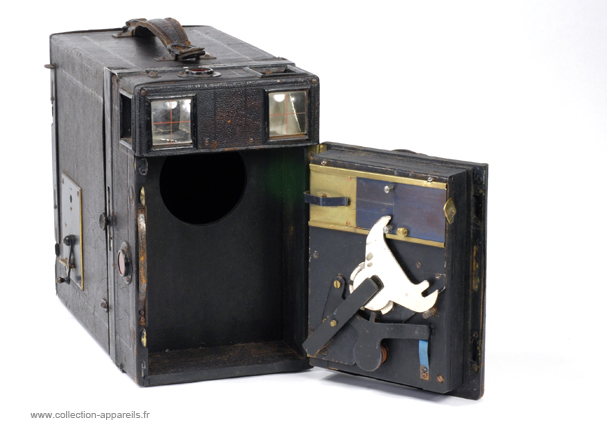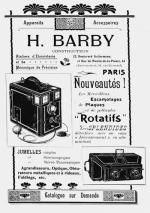|
Barby, H. Détective à double décentrement |
Manufactured or assembled in France from 1903 to (Circa) 1904.
Index of rarity in France: Infrequent (among non-specialized garage sales)
Inventory number: 7134
See the complete technical specifications
Chronology of cameras Barby, H.
Magazine Box cameras offering double decentering are really not many, but for a precise identification and especially to know the manufacturer, the path is not easy...
What is certain is that it has the same origin as the Ideal-Bernard. More interestingly, with very slight variations, it appears in the "Bon Marché" catalog of 1903. Certainly, the Bon Marché only sold, but on the vignette presenting the new detectives, you can see the letters "BY," indicating that these engravings come from the catalog of the probable manufacturer.
One can say that it is a high-end detective, very well constructed and finished, with a genuine maroquin covering. The plate-changing system is derived from the Lumière patent, but acting on the bottom, the plate holders only need nipples at the bottom.
The shutter is a simple guillotine, but the cocking is done by a easily recognizable nickel-plated piece. The different, uncalibrated speeds are obtained by a friction brake, which can be adjusted by a screw accessible on the front, which opens to allow cleaning of the mechanism and optics.
The lens is a Roussel Aplanatic on a helical mount. The last, truly uncommon feature on a detective, is the double decentering of the front, adjustable with precision thanks to graduated indexes, but nothing is provided to adjust the framing.
This kind of construction did not last long, as the Barby et Compagnie company was liquidated in 1902 and dissolved in 1903.


Barby by Étienne Gérard, Jean-Loup Princelle and Co
Jean Camille Barby, a colonial administrator residing at 34 Rue Monge, had a son named Henri with Mrs. Leschevin on April 5, 1876. They underwent a separation of bodies in 1884, followed by a divorce in 1896. On April 7, 1898, Jean remarried Jeanne Pauline Caroline Métais, a photographer at 8 Rue des Écoles. It's worth noting that these were different addresses, but in reality, they were part of the same building at the corner of the two streets. Also noteworthy is the renumbering of Rue Monge, with 34 becoming 20.
On January 9, 1901, a company named Barby, Métais et Cie was established among these three individuals. On November 11, 1901, this company, in association with Klopcic Janka, obtained a patent for a curtain shutter.
Henri filed other patents and additions under his name, and he appears to be the true inventor, while the company Barby, Métais et Cie managed the Comptoir Photographique Colonial at the addresses 8 Rue des Écoles and 20 Rue Monge, specializing in the sale of photographic equipment and cameras.
The 1901 catalog of the Comptoir, while concise, mentions the relocation of the small construction workshop from Rue Lhomond to the steam factory at 22 Boulevard Kellermann. This was, in fact, the takeover of the factory previously occupied by Attout Tailfer since 1884, located at 63 Rue du Moulin de la Pointe in the 13th arrondissement.
The company Barby et Cie went into judicial liquidation in 1902 and was dissolved in 1903. The assets were auctioned off on February 17, 1904.
The Comptoir Photographique Colonial continued its sales activities with Aubrun and Dardanne until 1910, and then with Eugène Hiard until 1940, with a change in name, becoming the Comptoir Photo-Colonial.
The factory continued to produce cameras under the Nurba brand, first with Aubrun and Dardagne until 1907, and then with Aubertin who retained the same brand in 1908. In 1911, the factory was owned by the association Loret, Vray, Pasquinot, and Duhallier, and later solely by Jean Pasquinot in 1913-14.
Henri Barby passed away in Grasse on May 8, 1952.
Evolution of the companies at 8 Rue des Écoles and 20 Rue Monge:
(34, rue Monge in 1897 and 1898)

In 1897, it was Métais & Cie located at 34 Rue Monge.
From 1898 to 1901, the business was operated by Jeanne Pauline Caroline Métais.
Starting in 1901 and possibly continuing until around 1908, the business operated under the name Barby, Métais & Cie, with the trade name "Comptoir Photographique Colonial." This name was mentioned in directories until 1908.

1910: Aubrun and Dardagne (Trading as Comptoir Photographique Colonial) (Sale to Hiard in 1910)
1910-1940: Eugène Hiard (Trading as Comptoir Photographique Colonial, later as Comptoir Photo-Colonial, with some overlap)

 The evolution of companies at 63 Rue du Moulin de la Pointe,
The evolution of companies at 63 Rue du Moulin de la Pointe,
where industrial buildings have been replaced by residential buildings, is as follows:
- 1884-1901: Attout Tailfer
- 1901-1904: Henri Barby (Barby & Cie)
- 1905-1907: Aubrun-Dardagne (under the Nurba brand)
- 1907-1908: Aubertin (under the Nurba brand)
- 1911: Loret, Vray, Pasquinot & Duhallier
- 1913-1914: Jean Pasquinot
Interesting links or bibliography :
 Annuaire du commerce et de l'industrie photographiques de 1902 |
Add a link or element of bibliography, a picture taken with this camera, a picture of box or an ads about this camera
Your photos taken with the same camera:
Cameras from Ebay France (Barby, H.) (Uploaded each 3 hours)








